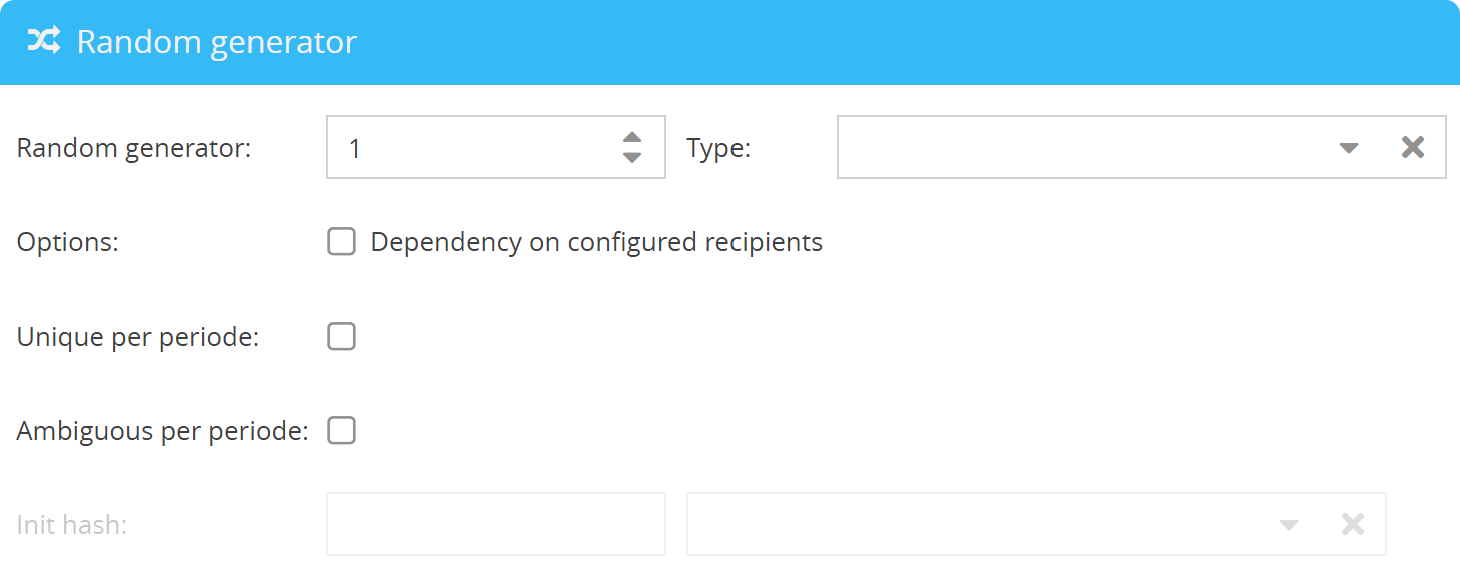Within the user tab you have the possibility to define a random recipient group. The random generator is available for this purpose:

Setting |
Description |
Random generator |
You can enter any number here. The entered number has an effect on the random generator (see table: Type). When using the percent type, the input is limited to a number between 1 & 100. |
Type |
Select the desired type of random generator here. You can choose from the following types:
- Amount (per server): This will notify a certain number of recipients per server. - Percent (all cluster server): Each Infoclient in the cluster has the previously specified percentage chance of receiving an Info. This means for a periodic Info that not X% of the recipients are notified, but rather that each Infoclient has an X percent chance of receiving the Info. - Hash (all cluster server): Hash basically works like percent. The advantage here is that you can use the assigned ID in the Init hash field to reach the same recipients multiple times. See example "Hash". |
Options |
The Dependency on configured recipients option allows you to specify that a random number of users within the used filters or groups of an Info should be addressed. |
Unique per periode |
Each client is addressed only once per Info. |
Ambiguous per periode |
A client can be randomly addressed several times per Info. |
Init hash |
If you use the hash type, enter any ID here. Then select whether the hash should be generated based on the users, computers or domain. |
Ambiguous per periode
The random generator is reset per period. So a user can get the same Info several times during the whole runtime.
Example |
Setting |
||
Random generator (User) |
10 |
||
Type (User) |
Percent (all cluster server) |
||
Ambiguous per period (User) |
Active |
||
Interval (Period) |
All 20 minutes for 1 minute |
||
Minutes (Time) |
10 minutes |
||
Begin (Time) |
Set a start date and time. |
||
End (Time) |
Set an end date and time. |
||
|
|||
Staggered Info (Unique per period):
With a staggered Info, a part of the recipient clients can be addressed in previously determined intervals.
This makes sense if, for example, you send a link that not all users should click on at the same time.
For staggered Info, "Unique per period" must be activated and a period must be created.
The (random) selection is recalculated per period so that the recipients are unique. This means that each client receives the Info only once during the entire runtime.
Example |
Setting |
||
Random generator (User) |
10 |
||
Type (User) |
Amount (per server) |
||
Unique per period (User) |
Active |
||
Interval (Period) |
All 20 minutes for 1 minute |
||
Minutes (Time) |
10 minutes |
||
Begin (Time) |
Set a start date and time. |
||
End (Time) |
Set an end date and time. |
||
Begin / End (Hint) |
Make sure that the time frame is big enough to send 10 Infos. |
||
|
|||
The display time (time -> minutes) of the Info determines how long each individual period of the Info is displayed on the client.
All-clear:
Staggered |
Setting |
Info and all clear |
Activate "Unique per period" for both. |
Only Info |
Activate "Unique per period" only for Info. |
Only all clear |
Activate "Unique per period" only for the all clear. |
The all-clear must always be set with "Dependency on configured recipients", otherwise the random generator will not access the receivers of the previous Info.
Random generator with hash
If you use the random generator with a hash value, you have the possibility to address a random recipient circle repeatedly.
To do this, select from the Hash type and enter any ID in the Init hash line. Then you select how the random hash should be generated. You can choose between user, computer or domain.
The created combination of ID and hash generation can be used to repeatedly address the randomly generated recipient circle.
Example |
Setting |
||
Random generator (User) |
10 |
||
Type (User) |
Hash (all cluster server) |
||
Init hash (User) |
LCIFK1 |
||
Init hash (User) |
User |
||
Minutes (Time) |
10 minutes |
||
|
|||